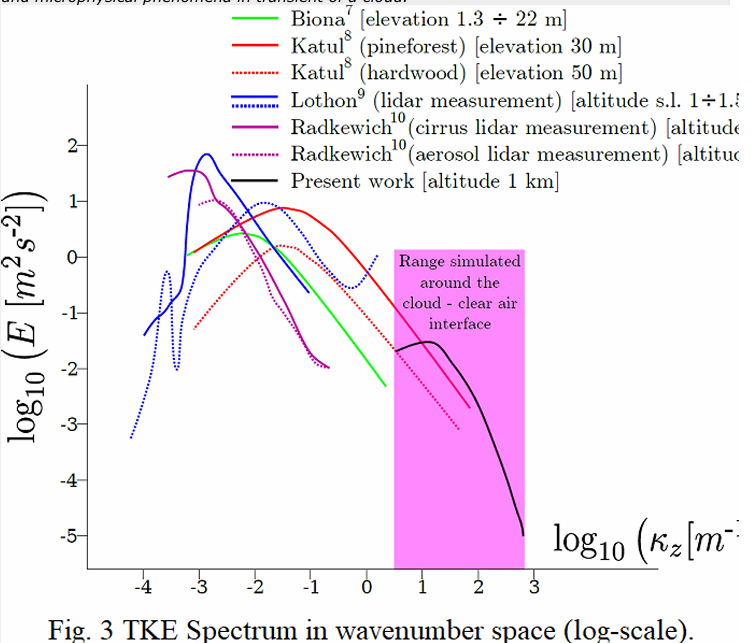30 Aug ISCRA class C (code: HP10CA7H4X)
Transient evolution of warm cloud and clear air interface and its impact on cloud droplet evolution (WISDOM)
Principal investigator: Prof Daniela Tordella
Research Group: Taraprasad Bhowmick, Mina Golshan, Tessa basso, David Codoni, Federico Fraternale
Warm cloud-clear air interfaces play an important role in the overall lifetime and in the evolution of the shape of a cloud through various physical processes, e.g., entrainment and mixing of dry clear air with the cloudy moist air behind the interface [Shaw, ARFM 2003]. Cloud measurements show that a cloud consists of a wide range of scales, ranging from several kilometers to millimeters (See Fig. 3 of the energy spectrum in wavenumber space). In our direct numerical simulations (DNS) code, we simulate the small-scale phenomenon as observed in the pink box region (Fig. 3). The turbulent kinetic energy (TKE) spectrum of our domain reflects the lower half of the inertial cascade, and it includes the physical processes related to the Taylor and Kolmogorov microscales. We simulate the warm cloud-clear air interface as an initial value problem with the TKE profile as shown in the pink box (Fig. 3), along with observed in-cloud temperature and relative humidity profiles. Turbulence conditions play an important role in the interfacial evolution of the fluid flow and influence the cloud microphysics, such as droplet inertial sedimentation, clustering, condensational growth, collision, and coalescence. Realistic DNS of cloud interface plays an important role in understanding the role of such small scales and microphysical phenomena in the transient of a cloud.

In this project, we aim to modify our present code and run small-scale simulations to build knowledge for future long-duration, larger domain simulations (PRACE Tier-0 resources). Our objective is to extend physical understanding of warm cloud-clear air interface phenomena through realistic DNS simulations. In fact, it is necessary to analyse the interfacial evolution of droplets of sizes effective for collision and coalescence to result in possible precipitation (droplet radius > 1 mm). Specific objectives of this project are divided into three parts. First, we want to modify our code to efficiently output the simulated cloud droplets in a single file at each saving instant (the present version saves particle data from each core in different files). This is complex since the number of droplets seen by each core is different due to enhanced droplet clustering produced by the anisotropic turbulence. Second, we wish to run simulations in 3 different grids (512^2 x 1024, 384^2 x 768, 256^2 x 512) using same physical conditions, to investigate the importance of spatial and temporal resolutions for simulating droplet microphysical phenomena (see Fig. 4). Third, we simulate 512^2 x 1024 grid domain with various physical conditions to evaluate the sensitivity of fluid motion and cloud droplet transient to various control parameters (Fig. 4). The control parameters are turbulent kinetic energy gradient, length-scale gradient, and the stability of stratification in the domain.
All these simulation runs will help us to plan our future larger domain simulations in the order of 10^2 x 20 m^3 size. To extrapolate information for the next Tier-0 submission, we wish to run a very short-term (0.2 eddy turnover time) simulation on a larger grid as 1024^2 x 2048. Our systems are actually initial value problems, where various turbulent parameters are specified as initial conditions, and the flow and the droplets evolve according to the initial turbulent conditions. The novelty of this approach is that we may observe a transient decay or growth of TKE, enstrophy, water vapor/droplets related parameters [Andrejczuk et al., JoAS 2006]. Successful completion of this project will have a considerable impact on the cloud physics community. The calculated fields with the related parametrization can also be used to update sub-grid scale turbulence models used in LES of clouds.



